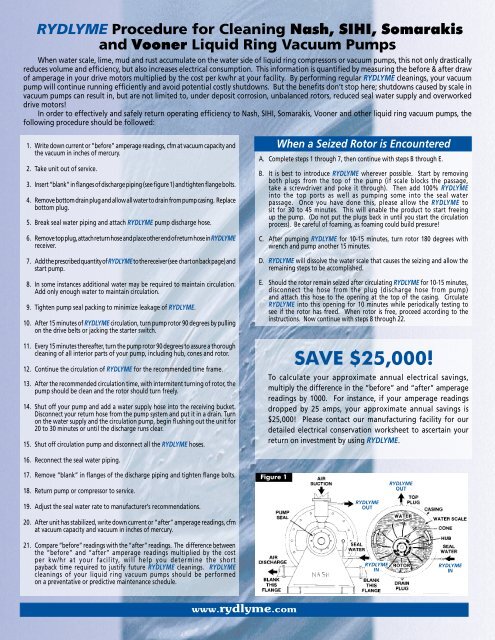Vacuum Pumps - Apex Engineering Products Corporation
Vacuum Pumps - Apex Engineering Products Corporation
Vacuum Pumps - Apex Engineering Products Corporation
Create successful ePaper yourself
Turn your PDF publications into a flip-book with our unique Google optimized e-Paper software.
RYDLYME Procedure for Cleaning Nash, SIHI, Somarakis<br />
and Vooner Liquid Ring <strong>Vacuum</strong> <strong>Pumps</strong><br />
When water scale, lime, mud and rust accumulate on the water side of liquid ring compressors or vacuum pumps, this not only drastically<br />
reduces volume and efficiency, but also increases electrical consumption. This information is quantified by measuring the before & after draw<br />
of amperage in your drive motors multiplied by the cost per kw/hr at your facility. By performing regular RYDLYME cleanings, your vacuum<br />
pump will continue running efficiently and avoid potential costly shutdowns. But the benefits don’t stop here; shutdowns caused by scale in<br />
vacuum pumps can result in, but are not limited to, under deposit corrosion, unbalanced rotors, reduced seal water supply and overworked<br />
drive motors!<br />
In order to effectively and safely return operating efficiency to Nash, SIHI, Somarakis, Vooner and other liquid ring vacuum pumps, the<br />
following procedure should be followed:<br />
1. Write down current or “before” amperage readings, cfm at vacuum capacity and<br />
the vacuum in inches of mercury.<br />
2. Take unit out of service.<br />
3. Insert “blank” in flanges of discharge piping (see figure 1) and tighten flange bolts.<br />
4. Remove bottom drain plug and allow all water to drain from pump casing. Replace<br />
bottom plug.<br />
5. Break seal water piping and attach RYDLYME pump discharge hose.<br />
6. Remove top plug, attach return hose and place other end of return hose in RYDLYME<br />
receiver.<br />
7. Add the prescribed quantity of RYDLYME to the receiver (see chart on back page) and<br />
start pump.<br />
8. In some instances additional water may be required to maintain circulation.<br />
Add only enough water to maintain circulation.<br />
9. Tighten pump seal packing to minimize leakage of RYDLYME.<br />
10. After 15 minutes of RYDLYME circulation, turn pump rotor 90 degrees by pulling<br />
on the drive belts or jacking the starter switch.<br />
11. Every 15 minutes thereafter, turn the pump rotor 90 degrees to assure a thorough<br />
cleaning of all interior parts of your pump, including hub, cones and rotor.<br />
12. Continue the circulation of RYDLYME for the recommended time frame.<br />
13. After the recommended circulation time, with intermitent turning of rotor, the<br />
pump should be clean and the rotor should turn freely.<br />
14. Shut off your pump and add a water supply hose into the receiving bucket.<br />
Disconnect your return hose from the pump system and put it in a drain. Turn<br />
on the water supply and the circulation pump, begin flushing out the unit for<br />
20 to 30 minutes or until the discharge runs clear.<br />
15. Shut off circulation pump and disconnect all the RYDLYME hoses.<br />
16. Reconnect the seal water piping.<br />
17. Remove “blank” in flanges of the discharge piping and tighten flange bolts.<br />
18. Return pump or compressor to service.<br />
19. Adjust the seal water rate to manufacturer‘s recommendations.<br />
20. After unit has stabilized, write down current or “after” amperage readings, cfm<br />
at vacuum capacity and vacuum in inches of mercury.<br />
21. Compare “before” readings with the “after” readings. The difference between<br />
the “before” and “after” amperage readings multiplied by the cost<br />
per kw/hr at your facility, will help you determine the short<br />
payback time required to justify future RYDLYME cleanings. RYDLYME<br />
cleanings of your liquid ring vacuum pumps should be performed<br />
on a preventative or predictive maintenance schedule.<br />
www.rydlyme.com<br />
When a Seized Rotor is Encountered<br />
A. Complete steps 1 through 7, then continue with steps B through E.<br />
B. It is best to introduce RYDLYME wherever possible. Start by removing<br />
both plugs from the top of the pump (if scale blocks the passage,<br />
take a screwdriver and poke it through). Then add 100% RYDLYME<br />
into the top ports as well as pumping some into the seal water<br />
passage. Once you have done this, please allow the RYDLYME to<br />
sit for 30 to 45 minutes. This will enable the product to start freeing<br />
up the pump. (Do not put the plugs back in until you start the circulation<br />
process). Be careful of foaming, as foaming could build pressure!<br />
C. After pumping RYDLYME for 10-15 minutes, turn rotor 180 degrees with<br />
wrench and pump another 15 minutes.<br />
D. RYDLYME will dissolve the water scale that causes the seizing and allow the<br />
remaining steps to be accomplished.<br />
E. Should the rotor remain seized after circulating RYDLYME for 10-15 minutes,<br />
disconnect the hose from the plug (discharge hose from pump)<br />
and attach this hose to the opening at the top of the casing. Circulate<br />
RYDLYME into this opening for 10 minutes while periodically testing to<br />
see if the rotor has freed. When rotor is free, proceed according to the<br />
instructions. Now continue with steps 8 through 22.<br />
Figure 1<br />
SAVE $25,000!<br />
To calculate your approximate annual electrical savings,<br />
multiply the difference in the “before” and “after” amperage<br />
readings by 1000. For instance, if your amperage readings<br />
dropped by 25 amps, your approximate annual savings is<br />
$25,000! Please contact our manufacturing facility for our<br />
detailed electrical conservation worksheet to ascertain your<br />
return on investment by using RYDLYME.<br />
RYDLYME<br />
OUT<br />
RYDLYME<br />
IN<br />
RYDLYME<br />
OUT<br />
RYDLYME<br />
IN


